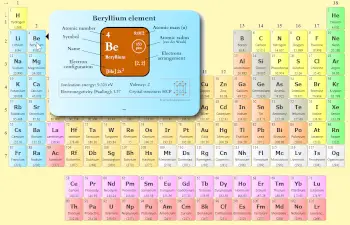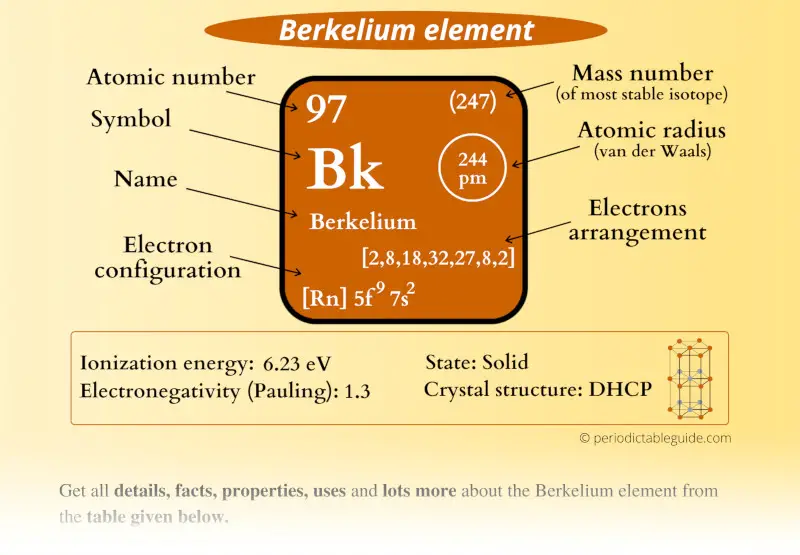
This is a SUPER easy guide on Berkelium element.
In fact, the table mentioned below is the perfect information box (Which gives you every single detail about the Berkelium element in Periodic table.)
So if you want to know anything about Berkelium element, then this guide is for you.
Let’s finish this very quickly.
Berkelium Element (Bk) Information
| Appearance | 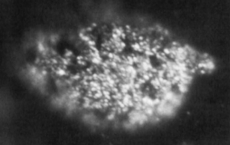 Silvery white |
| State (at STP) | Solid |
| Position in Periodic table | 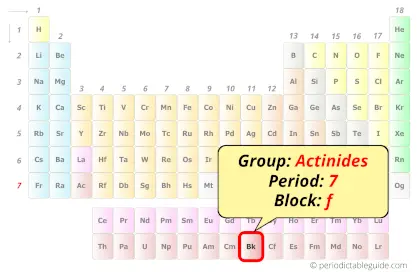 Group: actinides, Period: 7, Block: f |
| Category | 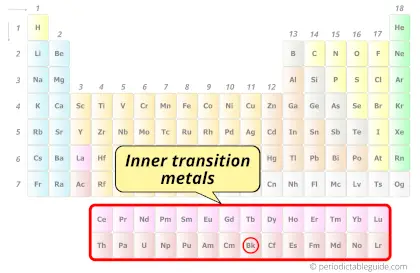 Inner transition metals |
| Atomic number or Protons | 97 |
| Neutrons | 150 |
| Electrons | 97 |
| Symbol | Bk |
| Atomic mass of Berkelium (most stable isotope) | 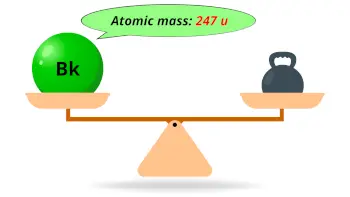 247 u |
| Electrons arrangement or Bohr model | 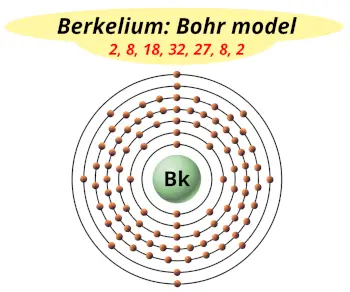 2, 8, 18, 32, 27, 8, 2 |
| Electronic configuration | [Rn] 5f9 7s2 |
| Atomic radius | 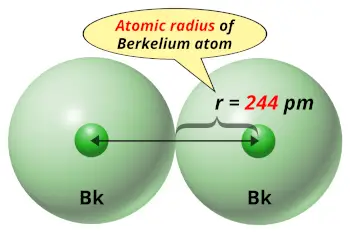 244 picometers (van der Waals radius) |
| 1st Ionization energy | 6.23 eV |
| Electronegativity | 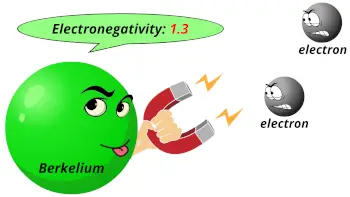 1.3 (Pauling scale) |
| Crystal structure | 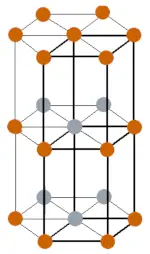 DHCP (Double hexagonal close packed) |
| Melting point | 1259 K or 986 °C or 1807 °F |
| Density | 14.79 g/cm3 |
| Main isotopes | 247Bk and 249Bk |
| Who discovered Berkelium and when? | Glenn T. Seaborg, Albert Ghiorso, Kenneth Street Jr. and Stanley G. Thompson (in 1949) |
| CAS number | 7440-40-6 |
Berkelium in Periodic table
Berkelium element is in period 7 and in actinides group of the Periodic table. Berkelium is the f-block element and it belongs to inner transition metals group.
| H | He | ||||||||||||||||
| Li | Be | B | C | N | O | F | Ne | ||||||||||
| Na | Mg | Al | Si | P | S | Cl | Ar | ||||||||||
| K | Ca | Sc | Ti | V | Cr | Mn | Fe | Co | Ni | Cu | Zn | Ga | Ge | As | Se | Br | Kr |
| Rb | Sr | Y | Zr | Nb | Mo | Tc | Ru | Rh | Pd | Ag | Cd | In | Sn | Sb | Te | I | Xe |
| Cs | Ba | La* | Hf | Ta | W | Re | Os | Ir | Pt | Au | Hg | Tl | Pb | Bi | Po | At | Rn |
| Fr | Ra | Ac** | Rf | Db | Sg | Bh | Hs | Mt | Ds | Rg | Cn | Nh | Fl | Mc | Lv | Ts | Og |
| *Ce | Pr | Nd | Pm | Sm | Eu | Gd | Tb | Dy | Ho | Er | Tm | Yb | Lu | ||||
| **Th | Pa | U | Np | Pu | Am | Cm | Bk | Cf | Es | Fm | Md | No | Lr |
←Move to: Curium (Cm) element – Periodic Table
→Move to: Californium (Cf) element – Periodic Table
Why is Berkelium in Period 7?
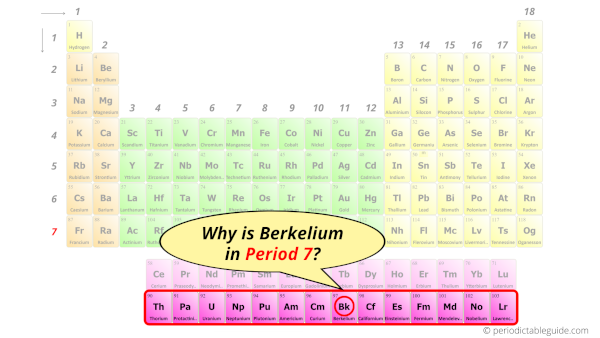
Let me ask you a question.
How many shells does berkelium have?
It’s 7. Right?
You have already seen the bohr model of berkelium atom in the above table.
From the Bohr model, it can be found that the number of orbits or shells in berkelium is 7. Hence, as berkelium has 7 orbits, it lies in period 7 of the Periodic table.
Why is Berkelium in f-block?
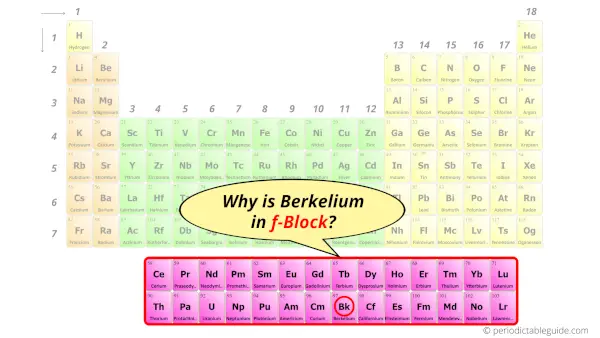
Before knowing this reason, first of all I want to ask you a simple question.
How can you determine the blocks-wise position of elements?
The simple answer: The elements will lie in the s, p, d or f block will completely depend upon the subshell in which the last electron will enter.
For example; the electron configuration of berkelium is [Rn] 5f9 7s2.
So the last electron of berkelium enters the f-subshell or f-orbital.
Hence, berkelium is the f-block element.
5 Interesting facts about Berkelium
Interesting facts about berkelium element are mentioned below.
- As this element was discovered in the Lawrence Berkeley National Laboratory in California, it was named “Berkelium”.
- Berkelium was discovered by Glenn T. Seaborg, Albert Ghiorso, Kenneth Street Jr. and Stanley G. Thompson in 1949. [1]
- Berkelium is a synthetic element which can only be prepared in a laboratory, and till now a very small amount of berkelium has been produced.
- Berkelium has around 20 isotopes and all of them are radioactive in nature.
- Out of all the isotopes of berkelium, the isotope 247Bk, has a longest half life of 1380 years.
Properties of Berkelium
The physical and chemical properties of berkelium element are mentioned below.
Physical properties of Berkelium
Physical properties of berkelium are mentioned below.
- Berkelium is solid at STP and has a silvery metallic appearance
- At room temperature, the crystal structure of berkelium is double hexagonal close packed. But at higher temperatures, this crystal structure changes to face centered cubic.
- The atomic mass of the most stable isotope of berkelium is 247 u and its density is 14.79 g/cm3.
- The melting point of berkelium is 986 °C which is less than its preceding element curium (1340 °C) and higher than its succeeding element californium (900 °C).
Chemical properties of Berkelium
Chemical properties of berkelium are mentioned below.
- Berkelium is reactive to oxygen and forms a thin oxide layer at higher temperature.
- Berkelium dissolves in aqueous mineral acids and during this reaction, it liberates hydrogen gas.
- In aqueous state, berkelium exists in its trivalent state (+3).
- Berkelium also shows reaction with hydrogen, halogens, as well as molten metals.
Uses of Berkelium
Berkelium is generally used for research work in chemistry. Berkelium does not have more commercial uses due to its radioactive nature.
Free Gift for you: Interactive Periodic Table
Let me tell you how this Interactive Periodic Table will help you in your studies.
1). You can effortlessly find every single detail about the elements from this single Interactive Periodic table.
2). You will get the detailed information about the periodic table which will convert a newbie into pro.
3). You will also get the HD images of the Periodic table (for FREE).
Checkout Interactive Periodic table and download it’s high resolution image now (It’s FREE)
External resources:
- Berkelium – Element information, properties and uses | Periodic Table. (n.d.). Berkelium – Element Information, Properties and Uses | Periodic Table. https://www.rsc.org/periodic-table/element/97/berkelium
- Berkelium – Wikipedia. (2010, March 1). Berkelium – Wikipedia. https://en.wikipedia.org/wiki/Berkelium
- Berkelium | Properties, Use, & Facts. (n.d.). Encyclopedia Britannica. https://www.britannica.com/science/berkelium
- P. (n.d.). Berkelium | Bk (Element) – PubChem. Berkelium | Bk (Element) – PubChem. https://pubchem.ncbi.nlm.nih.gov/element/Berkelium
- It’s Elemental – The Element Berkelium. (n.d.). It’s Elemental – the Element Berkelium. https://education.jlab.org/itselemental/ele097.html
- C&EN: IT’S ELEMENTAL: THE PERIODIC TABLE – BERKELIUM. (n.d.). C&EN: IT’S ELEMENTAL: THE PERIODIC TABLE – BERKELIUM. https://pubsapp.acs.org/cen/80th/berkelium.html?
- Thompson, S., Ghiorso, A., & Seaborg, G. (1950, April 26). THE NEW ELEMENT BERKELIUM (ATOMIC NUMBER 97). https://doi.org/10.2172/932815
- Thompson, S. G., Ghiorso, A., & Seaborg, G. T. (1950, December 1). The New Element Berkelium (Atomic Number 97). Physical Review, 80(5), 781–789. https://doi.org/10.1103/physrev.80.781
